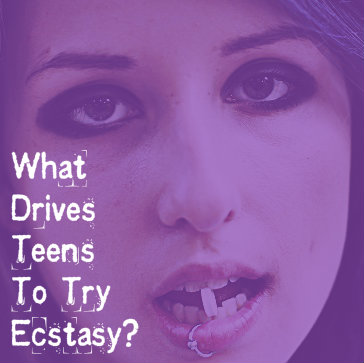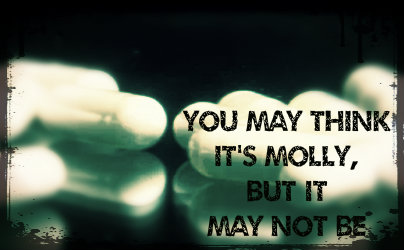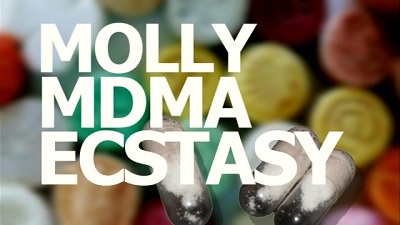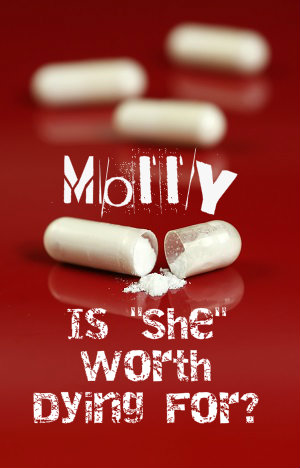29 Oct 2013
What Drives Teens To Try Ecstasy?
Ecstasy is a widespread term used for MDMA or Molly, an illegal amphetamine-like drug that also has some of the properties of hallucinogenic substances. In a study published in October 2013 in the journal Addiction, a multi-institution Australian research team examined some of the main factors that drive involvement in Ecstasy use. These researchers found that the critical factors include one’s social environment, previous history of drug use and level of a mental state called psychological distress.
Effects And Details Of Ecstasy
 The full chemical name of Ecstasy (MDMA) is methylenedioxymethamphetamine. Outside of very limited situations, manufacturers produce this substance illegally, and distributors also usually sell it outside of legal channels. The stimulant effects of Ecstasy produce alertness and high levels of energy, while the hallucinogen-like effects of the drug produce an impaired ability to track the passing of time and unusual sensitivity to sound and touch. In addition, the drug commonly produces a benevolent mental outlook and an increased sense of social/spiritual connection with others. Ecstasy users typically view these physical and psychological changes as the drug’s desirable effects.
The full chemical name of Ecstasy (MDMA) is methylenedioxymethamphetamine. Outside of very limited situations, manufacturers produce this substance illegally, and distributors also usually sell it outside of legal channels. The stimulant effects of Ecstasy produce alertness and high levels of energy, while the hallucinogen-like effects of the drug produce an impaired ability to track the passing of time and unusual sensitivity to sound and touch. In addition, the drug commonly produces a benevolent mental outlook and an increased sense of social/spiritual connection with others. Ecstasy users typically view these physical and psychological changes as the drug’s desirable effects.
The use of Ecstasy is heavily associated with attendance at parties or dances that feature some form of electronic music; however, use can also take place in a range of other settings. The drug disrupts the body’s ability to regulate its internal temperature. In combination with the high, external body heat levels commonly found at the parties and dances where Ecstasy use occurs, this temperature dysregulation can lead to a dangerous, sometimes lethal condition called hyperthermia, which sets in when the body’s temperature rises above a sustainable level. Additional, major short-term health problems associated with Ecstasy intake include seizures and the development of significant heartbeat instability. Typically, people who take large amounts of the drug in a short span of time have the highest risks for experiencing these problems.
Psychological Distress And Ecstasy
Psychological distress is a term used to describe the presence of a range of emotional states that can undermine a person’s sense of mental well-being. Examples of these emotions include nervousness, hopelessness, restlessness and a “down” mood. By itself, psychological distress does not constitute a diagnosable mental health disorder. However, the underlying effects of a distressed psychological outlook are known contributors to the development of a number of diagnosable mental illnesses, including schizophrenia, bipolar disorder, anxiety disorders and major depression. According to figures compiled by the federal Substance Abuse and Mental Health Services Administration (SAMHSA), young adults experience psychological distress considerably more often than middle-aged adults or elderly adults, and also receive help for their condition less often than adults in these age groups.
Social Environment, Past Drug Use – Factors In Ecstasy Use
In the study published in Addiction, researchers from five Australian institutions used an assessment of 204 young adults between the ages of 19 and 23 to look at the factors that contribute to the start of participation in Ecstasy use. At the beginning of the study, none of these adults had used Ecstasy; however, over 40 percent of them had been offered the drug at some point. Six months later, the researchers identified the participants who had eventually accepted an offer to take Ecstasy and examined the reasons for this change in behavior.
After completing their assessment, the researchers concluded that factors related to an individual’s social environment played the most prominent role in the onset of Ecstasy use among the study’s young adults. Specific factors cited include having social interactions with a lot of people who already use the drug and attending the electronic music/dance events classically associated with Ecstasy use. The presence of the symptoms of psychological distress also played a meaningful role, as did a previous history of using marijuana or other forms of cannabis. However, these factors did not rise to the same level of importance as social environment.
How Study Results Can Help Ecstasy Drug Education
The authors of the study published in Addiction believe that their research can play a role in efforts aimed at curbing the use of Ecstasy and warning users about the drug’s major pitfalls. If successful, such efforts would likely have two components: a large-scale education campaign designed to reach broad segments of the population and a smaller, more targeted campaign designed to reach young adults and other individuals exposed to known risk factors for Ecstasy use.
17 Oct 2013
You May Think It’s Molly, But It May Not Be
Hospitals face a difficult problem whenever someone comes in to be treated for a Molly overdose. The patient may believe they’ve taken a form of ecstasy, but there is no way to know what the person actually swallowed. There is no “Truth in Labeling Law” to govern illegal drugs, and many think they’ve been using Molly when they’ve really been taking some other highly dangerous substance.

Courtesy of: www.ktsm.com
Molly is the street name for the synthetic drug MDMA. It’s called Molly because of the powder or capsule form that it comes in, as opposed to tabs, and the presumption that the “molecular,” or Molly for short, form is more pure. Synthetic drugs are also sometimes referred to as designer drugs. They are often compounds designed to mimic the effects of traditional drugs like marijuana, LSD or ecstasy, among others. Synthetic marijuana, for example, is sold as K2 or Spice.
Mislabeled And Dangerous Synthetic Designer Drugs
The problem is that you don’t know the person who designed your Molly. The Drug Enforcement Agency regularly tests the drugs it obtains through seizures. Those tests often reveal that pills are mislabeled.
Experts often find methylone in the pills, which is a key component in bath salts, another synthetic drug famous for being unpredictable and causing serious health side effects. In 2012 a man was arrested for importing methylone from China and then selling it to someone as Molly. That person died after using the drug.
Dangerous Side-Effects Of Molly
Molly is a popular drug for young people attending raves, dance clubs and concerts. The drug enhances positive emotions and feelings of bonding with others. However, Molly also increases a person’s heart rate and raises their body temperature, sometimes to extremes. One young man died with a body temperature of 109 after taking Molly. The risks of dehydration are so well known that special booths are often set up at events where Molly is expected to be used.
Symptoms commonly seen in hospitals include agitation, seizures, soaring fever and increased heartbeat. Since there is no way to know for certain what the young person actually ingested, the best hospital staff can do is to manage symptoms while they wait for the effects of the drug to wear off. Hardly reassuring.
Dying After Taking Molly
Over Labor Day weekend 2013 several young people died after taking Molly at various concert venues, with one multi-day concert in New York was shut down due to deaths. Nevertheless, rappers and rock stars continue to sing about the beauties of Molly. And young people continue to swallow whatever they are being told by their idols.
To Read More About Molly’s Dangerous Side-effects On Teens – Click Here
Searching for the ultimate high, teens share drugs, mix drugs and succumb to the ill after-effects that drugs impose on them. They are often smart enough to know that the drug will make them feel awful after the high has worn away, but addiction doesn’t respond well to this reasoning. To truly break a drug addiction, teens need professional guidance and treatment.

Courtesy of: www.pentagonpost.com
Molly, also known as ecstasy or MDMA, promises teens an exhilarating feeling. In an NBC news report, one young man said that he was lured by the intense high that Molly gave him. He was looking for something new and someone suggested to him that Molly was like a new form of the drug ecstasy.
MDMA’s Short High And Dangerous Side-effects
His first encounters with Molly made him feel great. He said that the drug made him feel very happy and excited. He felt on top of the world and it was exactly what he was looking for. But the happiness didn’t last long and the young man soon realized that the short time he was high came with a long sentence of feeling completely worn out, both physically and mentally.
When teens search for a great high, they don’t think about the ill effects the drug may cause. Part of that comes from living in the moment and not worrying about the consequences. Some might even say the consequences are worth it. But over time, the consequences get more intense, and like a wheel racing downhill they can’t find a way to stop, event when the consequences become too overwhelming and change their life for the worst.
When self-esteem plummets and fatigue becomes overwhelming, some teens may try to stop using by themselves. Molly causes withdrawal symptoms like heavy sweating, overheating, high blood pressure, extreme dehydration and in some cases death. It can also affect teens psychologically, sometimes causing short term psychosis.
How Addiction To Molly Takes You To A New Low
The young man who was interviewed by NBC said that he knew he was letting Molly control him when he started selling his child’s toys in order to get money for drugs. He could not believe the person that he had become and how his need for the drug had changed him so much. He had also been lured by the media, knowing that popular movie stars and musicians were using the drug.
Recovery From The Lows Of Molly
The only way he was able to break free from Molly was through a treatment center that guided him back into better mental and physical health. Through his experience he cautions teens to stay away from the lure of that high that inevitably and impersonally drops you off into the lowest low.
24 Sep 2013
Do Teens Know the Truth About Molly?
Who is Molly? Molly is the new name for the decades-old drug ecstasy, the drug that was responsible for three deaths and four people being hospitalized in critical condition over this past Labor Day weekend.
Description Of Molly
Molly is a synthetic, or man-made, drug. It first showed up on the streets in the 1980s as ecstasy. At the time it was called a club drug because young people enjoyed taking it when they went dancing, attended concerts or large parties. Today it’s sold in powder form, usually in capsule form but also sold as pills or tablets, with “Molly” connoting molecular purity.
 The pills are brightly colored and sometimes emblazoned with cartoonish images. Officially the drug is known as MDMA, which stands for 3,4-Methylenedioxymethamphetamine. If you saw a few words in there you thought you recognized like amphetamine and meth you were right. The drug is a stimulant, or amphetamine, resembling methamphetamine in the way it increases heart rate and stimulation while providing feelings of euphoria.
The pills are brightly colored and sometimes emblazoned with cartoonish images. Officially the drug is known as MDMA, which stands for 3,4-Methylenedioxymethamphetamine. If you saw a few words in there you thought you recognized like amphetamine and meth you were right. The drug is a stimulant, or amphetamine, resembling methamphetamine in the way it increases heart rate and stimulation while providing feelings of euphoria.
MDMA is a concoction combining a stimulant with an empathy-boosting chemical plus a psychedelic. Kids like to take Molly at large group events because the drug makes them feel more energized, less inhibited and closer to those around them. There’s also a sensation of heightened alertness.
Molly’s Risks
There’s also a down-side as it can lead to blurry vision, racing blood pressure and heartbeat and muscle cramps. Sometimes the person’s insides are so revved up that they develop hyperthermia. Long hours of dancing and pressing up against people in a crowd make heat stroke likely. Increased heart rate can easily become an arrhythmia or erratic heartbeat, and seizures have also been known to occur.
MDMA may ratchet up energy and perception but it often pulls down the user’s emotions, leaving them feeling depressed, sad and anxious. Problems with memory can result and these difficulties sometimes last up to a week or more. When a young person decides to mix MDMA with alcohol they increase the sedative effects as well as increasing their risk of becoming dehydrated.
The risk of dehydration with use of MDMA is real, so lots of users try to compensate by drinking more water. However, since it causes the body to retain fluids, the combination of MDMA and water can quickly create an imbalance of electrolytes. Kids who choose to combine Molly with caffeine increase their risk of dehydration while also dangerously increasing body temperature.
Impure MDMA
Called Molly because of supposed molecular purity, the drug is no more pure than any other illicit drug. In fact, MDMA is often cut or completely replaced with another substance known as PMA which produces similar effects. Some deaths attributed to MDMA have actually been caused by PMA. More than that, street drugs are made with no regulating oversight, meaning every batch is unique and users can’t expect one tablet to affect them precisely the same as the last. Many high profile deaths come about because a celebrity is using street drugs in a new city and expecting them to be exactly like those they used in another city — it just doesn’t happen that way.
Celebrity Push Of Molly
Ecstasy, MDMA, Molly — whatever you call it, the drug is enjoying renewed popularity spurred on by pop singers like Madonna, Kanye West and Miley Cyrus. The Monitoring the Future studies conducted by the National Institute on Drug Addiction report that MDMA is experiencing a resurgence among 20-somethings and even high schoolers.
Strong Opportunity For Parents And Teachers
The recent tragic deaths at the Electronic Music Festival in New York provide an opportunity for parents and teachers to talk with teens about the realities of using drugs like MDMA. No matter what pop singers or friends might say, no experience is worth dying for.
A new drug mimicking the effects of cocaine and ecstasy is making its way onto party scenes worldwide. Mephedrone or what is sometimes referred to as "MCAT" or "meow meow" is very addictive and may pose serious side effects. A new body of evidence suggests that the drug may result in long-term damage to the brain.
Read More
28 Sep 2012
Molly is a Popular Companion at Music Concerts
When you send your teen off to enjoy a concert with friends, there are probably some worries niggling in the back of your mind. What will they see, hear or do when they are largely free of adult supervision and surrounded by a large group of other young people? Young people who attended music festivals this past summer were definitely confronted with opportunities to use illicit substances. The most popular substance found among kids attending these events has been a substance commonly referred to as Molly.
Read More
It’s fairly common for users of psychedelic drugs to experience disturbing side effects. What causes someone to see green leprechauns dancing around his feet or bugs crawling on his skin that aren’t really there? Neuroscientists have long been fascinated by how mind-altering drugs change chemistry in the brain, distorting one’s perception of reality.
Read More
If a woman takes ecstasy during pregnancy, she raises the risk of developmental delays in her infant, according to a new study from Case Western Reserve University School Of Medicine in cooperation with the University of London and Swansea University in the United Kingdom. Taking ecstasy during pregnancy also increases the likelihood that the baby will be a boy.


